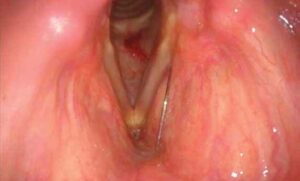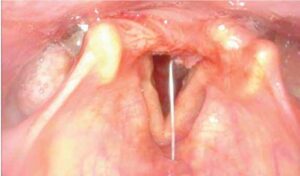Under direct visualization via a nasopharyngoscope held by an assistant, the 2.0-inch 25-gauge needle, prepared with the double- bend technique, is passed through the thyrohyoid membrane just superior to the thyroid notch to enter the endolarynx (Laryngoscope. 2021;131:E1580-E1588). The two intramuscular targets most frequently injected are the thyroarytenoid/lateral cricoarytenoid (TA/LCA) muscles and the interarytenoid (IA) muscle (also referred to as the transverse arytenoid). The TA/LCA injection is placed lateral and deep to the vocal process of the arytenoid (Figure 1). The interarytenoid muscle injection is placed at the junction of the interarytenoid region and arytenoid, inferior to the vocal process. A volume of 1 ml 1% lidocaine with epinephrine is injected into one or both areas. After several minutes, reduced mobility of the true vocal fold is confirmed with a nasopharyngoscope.
Explore This Issue
January 2023
Figure 1. An alternative approach targeting the thyroarytenoid muscle is placed deep and lateral to the vocal process of the arytenoid. This injection is most frequently used for vocal process lesions such as granulomas.
After completion of the therapeutic treatment, the patient is observed for 30 minutes in the clinic and instructed to follow nothing-by-mouth instructions for 90 minutes. Modifications for this procedure include using a longer 2.5-inch 25-gauge needle to reach the IA region for tall patients, patients with an increased neck circumference, adipose tissue, or altered anatomy due to previous surgical treatment or radiation. The transcricothyroid approach can also be used for IA muscle injection. Observation has shown that sometimes sufficient anesthesia is obtained through a single injection around the arytenoid, usually in the vicinity of the area of treatment (Figure 2).

Figure 2. Injection into the interarytenoid muscle to limit adduction. The needle tip is rotated so that the injection is concentrated on the left side.
RESULTS
This technique has been utilized for patients with lesions of the posterior larynx, including recurrent respiratory papillomatosis, leukoplakia, posterior glottic stenosis, and granulomas. Office-based procedures are the preferred method for administering serial treatments for highly recurrent or rapidly progressive diseases within our practice (see supplemental video).